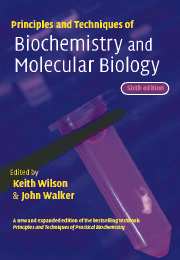Book contents
- Frontmatter
- Contents
- Preface to the sixth edition
- List of contributors
- List of abbreviations
- 1 Basic principles
- 2 Cell culture techniques
- 3 Centrifugation
- 4 Microscopy
- 5 Molecular biology, bioinformatics and basic techniques
- 6 Recombinant DNA and genetic analysis
- 7 Immunochemical techniques
- 8 Protein structure, purification, characterisation and function analysis
- 9 Mass spectrometric techniques
- 10 Electrophoretic techniques
- 11 Chromatographic techniques
- 12 Spectroscopic techniques: I Atomic and molecular electronic spectroscopy
- 13 Spectroscopic techniques: II Vibrational spectroscopy and electron and nuclear spin orientation in magnetic fields
- 14 Radioisotope techniques
- 15 Enzymes
- 16 Cell membrane receptors
- Index
- Plate sections
7 - Immunochemical techniques
Published online by Cambridge University Press: 05 June 2012
- Frontmatter
- Contents
- Preface to the sixth edition
- List of contributors
- List of abbreviations
- 1 Basic principles
- 2 Cell culture techniques
- 3 Centrifugation
- 4 Microscopy
- 5 Molecular biology, bioinformatics and basic techniques
- 6 Recombinant DNA and genetic analysis
- 7 Immunochemical techniques
- 8 Protein structure, purification, characterisation and function analysis
- 9 Mass spectrometric techniques
- 10 Electrophoretic techniques
- 11 Chromatographic techniques
- 12 Spectroscopic techniques: I Atomic and molecular electronic spectroscopy
- 13 Spectroscopic techniques: II Vibrational spectroscopy and electron and nuclear spin orientation in magnetic fields
- 14 Radioisotope techniques
- 15 Enzymes
- 16 Cell membrane receptors
- Index
- Plate sections
Summary
INTRODUCTION
The immune system
The immune system of animals is responsible for mounting immune responses against molecules recognised as being foreign (non-self). The science of immunology studies such responses and the immune system responsible for them.
The immune system provides protection for animals against infectious microorganisms (viruses, bacteria, mycoplasmas, fungi and protozoa) and also helps in the elimination of parasites and toxins. It combats tumours and neoplastic cells and can reject transfused cells and transplanted organs from genetically nonidentical animals. Its physiological role is to ensure that the animal is free from lifethreatening life forms and biological substances (the derivation of the word ‘immunology’ is from the Latin immunitas = freedom from). Inappropriate (i.e. undesirable) immune responses can cause clinical problems such as allergies, graft-versus-host disease and autoimmune disorders. Immune responses can be classified as either innate or aquired. Innate immunity does not require prior exposure to the foreign substance and is mediated mainly by cells of the monocytic lineage (e.g. macrophages) and polymorphonuclear leukocytes. Innate immunity is relatively non-specific, although it clearly normally distinguishes between self and non-self. It constitutes a potent, rapid-reacting, first-line defence against invasion and unwanted infection. Laboratory procedures based on innate immunity are limited in usefulness in general application to biochemical methodology.
Acquired immunity requires exposure (‘priming’) to the non-self material. It is mediated primarily by lymphocytes and may be further divided into cellmediated and humoral immune responses.
- Type
- Chapter
- Information
- Principles and Techniques of Biochemistry and Molecular Biology , pp. 292 - 348Publisher: Cambridge University PressPrint publication year: 2005
- 1
- Cited by



